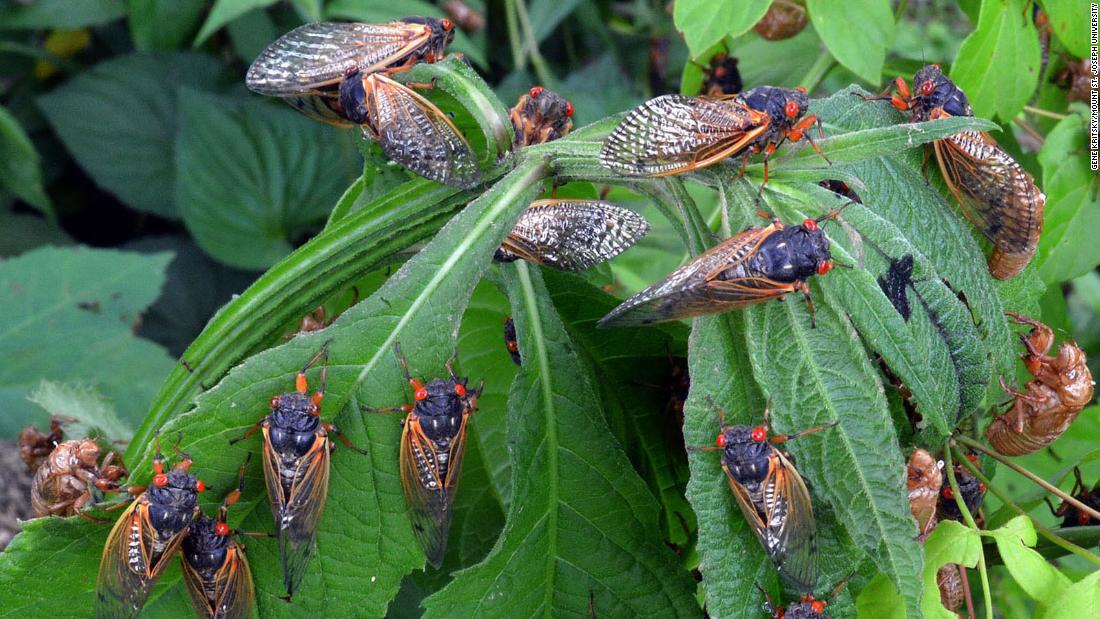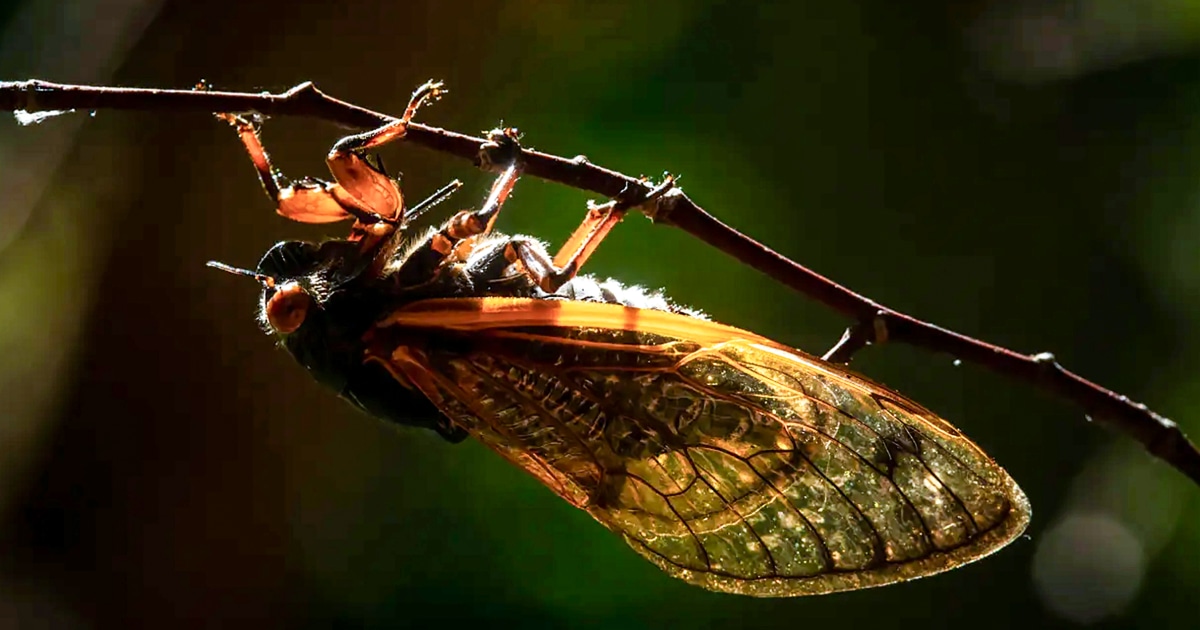Watch millions of cicadas invade the US 0:54
(CNN) -
Love is in the air this spring in the eastern United States, where billions of cicadas are showing up in the largest surfacing event since 2004.
The insects are part of a group called Generation X, also known as the Great Eastern Generation, which is expected to span a geographic range from Tennessee to New York.
These cicadas have been underground for 17 years, digging tunnels and feeding below ground.
When they are above the ground again, finding a mate will understandably be a top priority.
The loud buzz that cicadas make is actually a mating song emitted by male insects, flexing a drum-like organ called a timpani.
"It's all the boys calling the girls," said entomologist Eric Day of the Virginia Polytechnic Institute and State University Extension.
"First you have some here and there, then what happens is that they start in chorus, there are so many of them that the calls of the cicadas are combined in this huge chorus."
While cicadas can be a nuisance to some gardeners and farmers, witnessing them is also an impressive experience, Day said.
«This is a real treat.
This is an unusual biological phenomenon.
Periodic cicadas only occur in the eastern United States;
they don't happen anywhere else in the world, ”he said.
"It's going to be an incredibly big show."
advertising
The appearance of cicadas is causing anxiety for some people
When and where will the cicadas come out this year?
Cicadas are expected to emerge from underground in the eastern United States.
The large-scale event occurs every 17 years.
That show doesn't start until the ground warms up.
The cicadas, which are not harmful to humans or animals, begin to emerge when the ground reaches 18 degrees Celsius, Day said.
Some individual cicadas emerge in mid-to-late April, Day said, lagging behind what the entomologist dubs "the loners," who call and call in vain.
The real full-scale resurgence occurs in May.
Scientists differ on the precise range of Generation X cicadas, but entomologist Gene Kritsky, dean of natural and behavioral sciences at Mount St. Joseph University in Cincinnati - and unofficial dean of Generation X cicadas - expects to see them in 14 states plus the District of Columbia.
Generation X - "X" is the Roman numeral for 10 - is the largest group of 17-year-old cicadas, said Kritsky, author of the new book
"Periodical Cicadas: The Brood X Edition."
(Other groups of periodical cicadas emerge on a 13-year cycle.)
Scientists do not know the precise reasons behind the cicadas' itineraries, or why both types of periodic cicadas have prime number lifetimes.
However, emerging en masse helps insects survive predation and mate successfully, as birds and small mammals can only catch a few cicadas at a time.
The large number of cicadas during this event can be a nuisance to farmers, but the insects are not harmful to humans or animals.
When it comes to such breeding strategies, this year's cicadas have a lot in common with other litters.
However, what distinguishes Generation X from other cicada emergencies is their proximity to large metropolitan areas.
"Approximately 35 million Americans will have the opportunity to interact with Generation X," Kritsky said, noting that they will likely be seen in Philadelphia;
Washington;
Baltimore;
Cincinnati;
and Indianapolis.
In the past, Generation X cicadas even emerged in New York City's Central Park.
The first signs of cicadas include finger-sized holes in the ground near the base of the trees.
You can also see a chimney-like tunnel sticking out of the ground.
When insects appear, they make an impressive amount of noise.
Once, Kritsky said, he recorded a cicada chorus while sitting in a graveyard under the flight path of the Cincinnati / Northern Kentucky International Airport in Hebron, Kentucky.
'Zombie cicadas' under the influence of a mind-controlling fungus have returned to West Virginia
The insects registered 96 decibels, drowning out the sound of passenger planes passing directly overhead.
However, the chorus will not last long.
Cicadas generally die four to six weeks after surfacing.
Will cicadas harm your garden?
When the cicadas emerge, gardeners can see the insects crawling on the plants, but there is nothing to worry about, said Paula Shrewsbury, an associate professor in the department of entomology at the University of Maryland (UMD).
"There is very little evidence that cicadas do any harm," said Shrewsbury, who is a member of UMD's self-proclaimed Cicada Crew and is teaching a periodic graduate class on cicadas this semester.
The insects will quickly move to the trees where they mate and lay eggs.
Cicadas prefer to lay eggs on the outer parts of pencil-sized branches, where they make a small indentation and create egg nests.
"Egg laying can damage tree tops and tree tops will die, it's called flagging," Shrewsbury said.
Older, more established trees can easily be recovered from flagging.
However, a small tree with a trunk diameter of about 2 inches or less could be vulnerable.
That means it is worth delaying new plantings and protecting existing small trees.
The buzzing comes from male cicadas looking to mate.
"Insecticides are not the best option," Shrewsbury said, adding that covering trees works better than chemicals.
Insecticides could also harm beneficial pollinators that flowering trees and plants depend on.
To cover small trees, enclose them in a net with holes less than one centimeter.
Tie a net at the bottom to prevent cicadas from climbing up, Shrewsbury said, making sure to secure the seam tightly as well.
In general, he said, cicadas benefit gardens.
When insects emerge from the ground, they create holes that increase aeration and water penetration.
During the life cycle of cicadas, exoskeletons and dying adults will fall to the ground, breaking down into organic matter and nutrients that feed the soil.
Leave the exoskeletons and cicada bodies where they are, Shrewsbury said, or rake them up and throw them in your compost pile.
Climate change: a project that seeks to protect and restore forests around the world
Citizen Scientists Improve Cicada Map
What should you do if you see a Generation X cicada?
Enjoy it, first of all.
If the hordes of insects emerging from the ground sound like a sign of the end of time, consider this instead an extraordinary opportunity to see a glorious and somewhat mysterious natural event.
People have been marveling at the appearance of these insects for a long, long time.
The first written record of emerging Gene X cicadas is from 1715, said Kritsky, the entomologist, when Swedish shepherd Rev. Andreas Sandel saw the insects in Philadelphia.
The people there, mistaking the cicadas for (unrelated) locusts that appear in the Bible and the Torah, opened the insects and ate them.
Eating cicadas is definitely an option.
They are a low-fat source of protein.
Dogs and cats can also try to eat them.
Cicadas are not toxic, so don't worry if your pet catches one, but experts at the Animal Medical Center in New York City recommend that you don't let it gorge itself.
If you or your pet want to eat a cicada, Kritsky wants you to take a photo first.
He is a co-creator of the Cicada Safari app, designed to use date and location image submissions to enhance existing Generation X maps.
"We hope that people will come out and tell us where the cicadas emerge," Kritsky said.
"Once we approve that photograph, it is posted on our map so that people can follow the emergence as it happens, day by day."
Given the size of the Generation X distribution, Kritsky noted that it is impossible for a single laboratory to comprehensively track the phenomenon without the help of volunteers.
"If you have a lot of boots on the ground and a verification system, you can really get a solid map," he said.
Cicadas at risk from habitat loss and climate change
Adjusting the maps of the emergence of cicadas is important in part because scientists, including Kritsky, are working to understand how habitat loss and climate change are affecting insects.
Concern for the welfare of cicadas is nothing new.
"In the 1890s, the USDA thought that cicadas were going extinct," Kritsky said.
Even at that time, scientists noticed how logging and deforestation were decreasing the cicada population.
That's an ongoing trend, Kritsky said.
"Distribution is being affected by deforestation for agriculture and now deforestation for urbanization."
The felling of roads and power lines is also a problem, as is the mass extinction of trees in the Midwest due to infestations of the emerald ash borer.
Climate change affects the emergency in two main ways, Kritsky said.
The first is a trend toward an earlier emergence driven by warmer spring weather.
In southwestern Ohio, an area where Kritsky has studied historical data, the mass appearance of cicadas occurs an average of two weeks earlier than before 1950.
Zombie fires may be more common due to climate change, study finds
The other impact of climate change is more complex.
There has been an increase in the "side effects" of cicadas, when a group of insects emerge years earlier than expected.
Why?
Cicadas count down to their appearance following the cycle of the seasons.
A mild winter that fluctuates between frost and thaw sometimes brings out insects, Kritsky thinks.
"It can make cicadas count for two years when only one has passed," he said.
In the year 2000, four years before the scheduled appearance of Generation X, the cicadas came out early.
Many died, but some in southwestern Ohio survived to form a separate group that resurfaced in 2017. “We had the first time we were able to document an off-cycle emergence.
Seventeen years later they came out in even greater numbers, ”Kritsky said.
Given the 17-year-old cicadas' natural time cycle, this will be only Kritsky's third chance to witness the emergence of a Generation X despite a lifetime of study of insects.
However, data contributed by citizen scientists in 2021 could help future researchers understand the huge group of cicadas.
"My hope is that we get a good baseline this year, that it serves as a way to really check how the cicada emergencies of the future happen," Kritsky said.
"I am 67 years old, but I will be very interested to see how Generation X compares when it comes out again in 2038."
Look for cicadas in Delaware, the District of Columbia, Georgia, Illinois, Indiana, Kentucky, Maryland, Michigan, New Jersey, New York, North Carolina, Ohio, Pennsylvania, Tennessee, and Virginia. Read more at Cicada Mania or Cicada Crew UMD. Gene Kritsky's upcoming "Brood X: The Cicada Podcast" was released on April 27.
Jen Rose Smith is a writer who lives in Vermont. Find her work at jenrosesmith.com or follow her on Twitter @jenrosesmithvt.
Cicadas




/cloudfront-eu-central-1.images.arcpublishing.com/prisa/M2CB2QD2YFDRNJMU6WKGSG3BTM.jpg)


/cloudfront-eu-central-1.images.arcpublishing.com/prisa/JC2C6E4UEBCBNF33BAF7RB2JS4.png)

/cloudfront-eu-central-1.images.arcpublishing.com/prisa/56OKJX7TANA2LFZHMK4BAUHUOE.jpg)